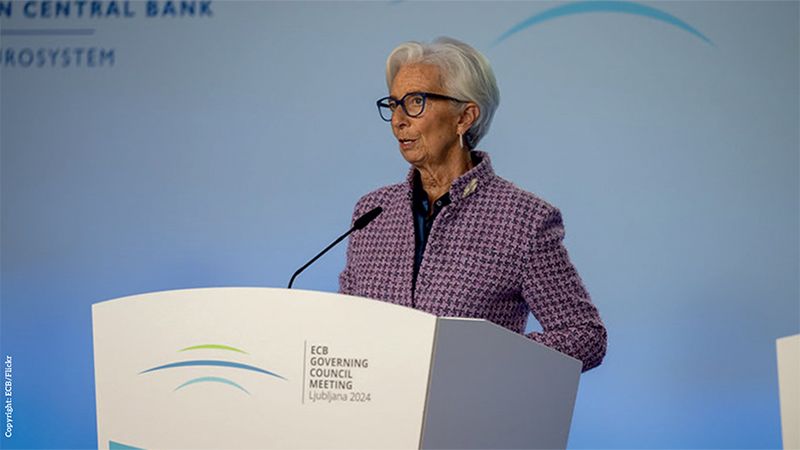This article was originally published by our sister title, Portfolio Adviser
The European Central Bank could be “behind the curve” in terms of its pace of interest rate cuts, according to some investment and economics professionals, who warn that investors will likely “remain in the dark before each upcoming meeting” as the bank carefully watches the data.
This afternoon (17 October), the ECB cut interest rates by 25 basis points to 3.25%, in a move that was widely expected by markets. This marked the second back-to-back rate cut from the bank for the first time in 13 years, and the third reduction in 2024 so far. It also ties in with eurozone inflation dipping below the 2% target during September, as well as weak economic data including declining business activity and a widening productivity gap relative to the US.
But given the backdrop, and despite today’s historic cut, Karsten Junius, chief economist at J. Safra Sarasin Sustainable Asset Management, believes the ECB “seems to be a bit behind the curve” by “only hesitantly cutting its policy rate”.
“September inflation was revised down to 1.7% year-on-year from 1.8% year-on-year,” he said. “While core and services inflation rates are still at 2.7% and 3.9% year-on-year, respectively, these indicators are slow-moving as wage negotiations are usually backward-looking and still partly reflecting the inflation shock of 2022.
See also: EIB expands financing initiatives to boost tech innovation
“Faster-adjusting producer prices are back to pre-pandemic levels and the ECB may consider that services inflation follows with some delay.”
The economist added that, over the medium term, inflation expectations remain “well anchored” and “do not have to be forced down with an overly restrictive monetary policy”.
“Until end 2025 market inflation expectations are significantly below ECB forecasts. While some risk and liquidity premia might distort the market data somewhat – the degree of the difference is too large to ignore.
“Finally, the ECB may want to consider the signals of the latest Bank Lending Survey that was also released this week. In general, banks’ net tightening of credit standards has dropped, and banks have even been easing them for home purchases.
“Loan demand is improving in all categories, partly due to the recent decline of bond yields. In our view, policy rates must decline further to stimulate an investment driven cyclical upswing. We expect further rate cuts at each of the next five policy meetings.”
Ann-Katrin Petersen, chief investment strategist for Germany, Austria, Switzerland and Eastern Europe at the BlackRock Investment Institute, agreed that the ECB is “moving into the fast lane but not going far”. She also concurred with Junius that a series of consecutive cuts is likely, although she believes that “only a further sharp economic deterioration would prompt the ECB to increase the size of coming cuts and rush to take rates below neutral”.
“The ECB has more room to ease than the Fed, having tightened policy more. But like the hiking cycle, this is not your typical cutting cycle: this is not a return to the world we once knew, where inflation was consistently well below the 2% target,” the investment strategist pointed out. “With easing but still-tight labour markets and productivity weak, domestic price pressures could keep inflation near or above 2%.
“We think wage growth will cool further, but services inflation is still too high at roughly 4% in September. Given the ECB raised rates into highly restrictive territory, even if it has moved into the fast lane, we still don’t think it will drive too far. We don’t think the ECB is going back to the old regime of very easy policy. Consecutive cuts would still leave policy weighing on growth well into 2025.”
Jochen Stanzl, chief market analyst at CMC Markets, also believes inflation in the eurozone could still rise again by the end of the year, with wage inflation proving “particularly problematic for the ECB, as it leads to rapid increases in rents, healthcare costs, and other service expenses”.
“Within the ECB’s Governing Council, Germany and Austria are the ones holding back when it comes to a quicker reduction in interest rates,” he explained. “A faster rate cut could benefit Germany’s economy, but the ECB’s mandate is not as broad as that of the US Federal Reserve. It focuses solely on inflation, not employment. As a result, the ECB must prioritise wage negotiations over the potential job losses at major corporations like Volkswagen or Thyssenkrupp.”
As a result, Stanzl said the ECB is only likely to commit to a particular rate path if inflation in the services sector stabilises. “Until then, it will continue to wait and see. Investors will likely remain in the dark ahead of each upcoming meeting, with no guarantee of further rate cuts nor a surprise reduction of 50 basis points,” he explained.
“Overall, the ECB’s decision is positive news for investors. Just a few weeks ago, this rate cut wasn’t expected. Investors now find themselves in a broadly positive environment, with the ECB supporting the bullish mood rather than obstructing it.”







